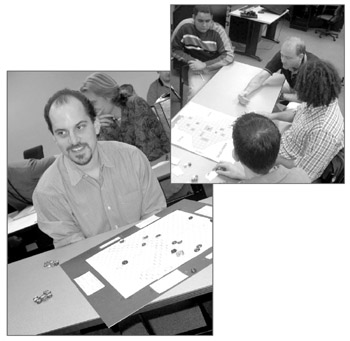Methods Of Playtesting
|
| < Day Day Up > |
|
Most professional usability testing takes place individually. It’s a generally accepted rule that group dynamics are good for generating ideas, but very bad for evaluating ideas. On the other hand, you may have no choice, depending on the nature of your prototype and environment. So, don’t feel like you can’t playtest just because you don’t have the “perfect” set-up.

Figure 8.4: More playtesting sessions for physical prototypes: Steve Ackrich of Atari and Neal Robison of VivendiUniversal give student designers feedback on their designs.
Here are a number of different ways you can structure your tests, each with their own positives and negatives, but one or more should work for the environment you have available.
-
One-On-One Testing: You sit down with individuals and watch over their shoulders as they play the game. You take notes and ask them questions along the way.
-
Group Testing: You get a group of people and allow them to play your game together. You observe the group and ask questions as they play.
-
Feedback forms: You give each person who tests your game a standard list of questions to answer after playing, and then compare the results.
-
Interview: You sit down face-to-face with the playtesters and give them an in-depth, oral interview after the playtesting session. This is not a discussion, it’s more of a verbal quiz.
-
Open Discussion: You conduct either a oneon-one discussion or a group discussion after a round of playtesting and take notes. You can either promote a freeform discussion or have more structure approach where you guide the conversation and introduce specific questions.
You can combine the previous approaches to fit your game and your space. For instance, you may have players play a game together and have a group discussion afterwards, but then ask each to fill out a feedback form individually. You’ll be surprised how differently people respond when there is no group dynamic.
Over time, you’ll find out which methods work best for you at each stage of testing. Our goal is to encourage you to test no matter what your limitations are. If none of the structures on our list work for you then think creatively and come up with your own methods. Try some of these different processes if you can. You’ll see how each method produces different results, and you’ll broaden your testing techniques and experience.
|
| < Day Day Up > |
|
EAN: 2147483647
Pages: 162